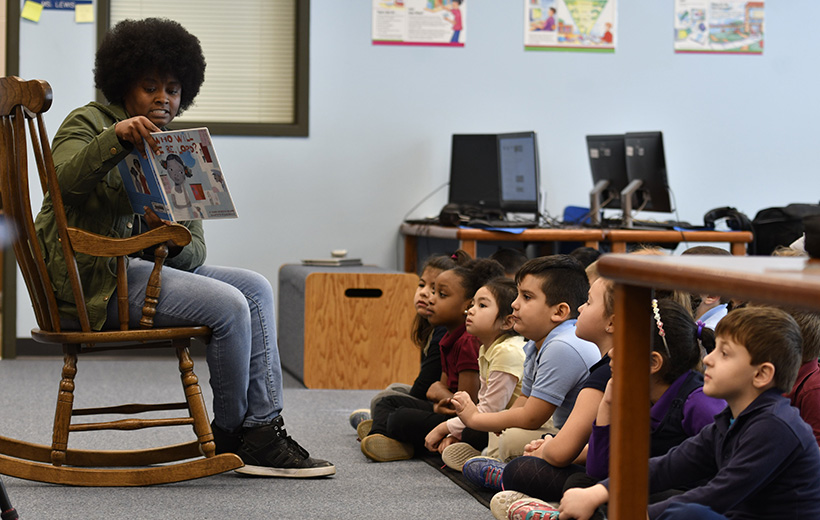This blog post was written by NCTE members Tiffany Flowers and Dorian Harrison.
Families offer so much to young children who are learning about the world. Children are learning routines, rules for home and school, and their place in this world. As early childhood professionals we know, a great deal of learning for children happens outside of the school building. This happens through after-school activities, hobbies, libraries, religious observances, family reunions, daily time spent with family members, and vacations.
The 21st century has created even more opportunities for children to have contact and to learn from various members of their families. As educators, it is of vital importance that we begin to integrate these learning experiences and opportunities for learning with our daily practices with children.
As we begin a new school year, it is important to do so with the idea that families offer so much for their children’s overall development. Beginning with the idea of parent partnerships in regards to literacy can only strengthen the bonds between parents and their children and can create a much needed collaboration between teachers and parents.
As teachers, it is imperative that we provide a beacon of resources for parents to help bridge the gap between resources and children’s literacy experiences. As we work to foster high-quality and engaging literacy experiences, family literacy plays a big role in this endeavor. Providing community resources available through both libraries and schools can offer some key experiences for parents to explore with their children at home.
10 Strategies for Fostering Family Literacy Experiences
- Visiting virtual children’s museums online offers online experiences for parents and children to explore together. (Explore this list: https://www.purewow.com/family/virtual-museum-tours-for-kids)
- Literacy Bags are available for check-out in some libraries, and offer books, songs, puppets, and a list of activities for parents and children to do together.
- Dial-a-Story is a free program available through many libraries that allows children and parents to listen to recorded stories read aloud over the phone.
- Digital picture book videos online through various websites where children can watch picture books being read aloud. (Here’s one example: https://www.storylineonline.net/)
- Digital audio stories read online for children. (For example, Audible has made many audio stories free on a temporary basis: https://stories.audible.com/start-listen)
- Hosting Family Literacy Nights at school to provide parents with activities to do with their children at home.
- Write an Author is a great activity parents can do with their children to connect with their favorite author.
- Visit Storytelling Circles through libraries, book fairs, and school events.
- Book Clubs are a great way to foster the love of reading and cooperation among children through book choices and discussions.
- E-book clubs let children subscribe and get books delivered each month to their homes.
We can also incorporate the knowledge we have about parent’s busy schedules into our planning and instruction. This knowledge is helpful when crafting newsletters to communicate with parents each week. Teaching parents fun ways to integrate literacy into home activities and sending home suggested literacy activities to parents is a great way to communicate each week. Below are eight ways parents and caregivers can use early literacy strategies within home routines.
8 Literacy Routines for Home Use
- Sing songs during meal preparation.
- Listen to audiobooks in the car or on the bus ride home.
- Allow children to watch and hear digital stories on phones or tablets.
- For parents or caregivers who have difficulty reading, the Dial-a-Story program (see description above) is one option to allow children to hear stories before going to sleep. Check with your local library to see if this is available.
- Check-out books and magazines from the library.
- Use magnetic letters on the refrigerator to give children more practice in learning letters and spelling their names.
- Read aloud the messages and signs that you see when you are in the car or taking a walk around your neighborhood or town.
- Label objects in the home to ensure children learn basic words such as lamp, door, refrigerator, etc.
 Tiffany A. Flowers is a native of Chicago, Illinois. Dr. Flowers is a children’s author, literacy advocate, and professor. Currently, she is an assistant professor of education in the department of cultural and behavioral sciences at Georgia State University Perimeter College. Dr. Flower’s research agenda is divided into four distinct and interrelated areas of research which includes, African American literacy development, children’s literature, diversity issues in education, and emergent literacy. You can contact her at tflowers@gsu.edu.
Tiffany A. Flowers is a native of Chicago, Illinois. Dr. Flowers is a children’s author, literacy advocate, and professor. Currently, she is an assistant professor of education in the department of cultural and behavioral sciences at Georgia State University Perimeter College. Dr. Flower’s research agenda is divided into four distinct and interrelated areas of research which includes, African American literacy development, children’s literature, diversity issues in education, and emergent literacy. You can contact her at tflowers@gsu.edu.
 Dorian Harrison is an assistant professor of education at Ohio State University Newark. Dr. Harrison’s research focuses on issues of identity and power in literacy education, paying particular attention to how race, class, and language impact teaching and learning. Through in-depth analyses of teaching/learning communities, her work seeks to challenge deficit views of students who are African American, Latinx, and identify as LGBTQIA. Her current research projects focus upon developing preservice teachers’ understanding of equity and advocacy; EL family narratives in school; and literacies in after-school spaces. She is currently serving on NCTE ‘s Committee Against Racism and Bias in the Teaching of English. You can contact her at harrison.898@osu.edu.
Dorian Harrison is an assistant professor of education at Ohio State University Newark. Dr. Harrison’s research focuses on issues of identity and power in literacy education, paying particular attention to how race, class, and language impact teaching and learning. Through in-depth analyses of teaching/learning communities, her work seeks to challenge deficit views of students who are African American, Latinx, and identify as LGBTQIA. Her current research projects focus upon developing preservice teachers’ understanding of equity and advocacy; EL family narratives in school; and literacies in after-school spaces. She is currently serving on NCTE ‘s Committee Against Racism and Bias in the Teaching of English. You can contact her at harrison.898@osu.edu.
It is the policy of NCTE in all publications, including the Literacy & NCTE blog, to provide a forum for the open discussion of ideas concerning the content and the teaching of English and the language arts. Publicity accorded to any particular point of view does not imply endorsement by the Executive Committee, the Board of Directors, the staff, or the membership at large, except in announcements of policy, where such endorsement is clearly specified.

